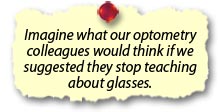|
|
|
Jarrod Shapiro, DPM
Practice Perfect Editor
Assistant Professor
Dept. of Podiatric Medicine
Surgery & Biomechanics
College of Podiatric Medicine
Western University of
Health Sciences
St. Pomona, CA |
Last week I treated a very nice lady who was complaining of painful hallux valgus and calluses plantar to the metatarsal heads two through four. One of the first things she said to me was, "Doctor, I'm not going to stop wearing my high heels ." Any podiatrist in practice more than five minutes has heard this statement repeatedly, and I can say I've heard this comment more times than I can remember. Despite the fact that this patient was previously treated for Morton's neuromas (imagine where those came from!) and having been told by several other physicians (yes, she's tried several other doctors – imagine that!) that her shoes were a major factor in her foot pathology, she continues to wear her fashion shoes. She was a very sweet lady who defiantly stiffened up her small five-foot frame when she made her statement to me.
 My patient had me thinking about shoes. I know it's not the most interesting topic in medicine. Perhaps it's less exciting than the biomechanics of this patient's feet and how that might play into any variety of interesting surgical procedures. Maybe shoes aren't as sexy as flatfoot reconstruction (many ladies – and men – will argue that!), but few subjects are more important than shoes to podiatric medicine. And few are more scoffed at by patients, despite the pain they are suffering, despite your firm statements that shoes are exacerbating their pain. My patient had me thinking about shoes. I know it's not the most interesting topic in medicine. Perhaps it's less exciting than the biomechanics of this patient's feet and how that might play into any variety of interesting surgical procedures. Maybe shoes aren't as sexy as flatfoot reconstruction (many ladies – and men – will argue that!), but few subjects are more important than shoes to podiatric medicine. And few are more scoffed at by patients, despite the pain they are suffering, despite your firm statements that shoes are exacerbating their pain.
In all honesty, we spend a very small amount of time teaching about footwear at the colleges. At Western University College of Podiatric Medicine, this topic has been relegated to accessory status, along with taping and padding, something to be taught as a workshop at the end of some class or via a student club. We do talk about shoes during our biomechanics classes, but it's still an afterthought even then. In clinic, I annoy my students by asking them about patients' shoes and work hard to have them include commentary about shoes in the chart. I also try to have the students educate patients about shoes. But that's it. Pretty weak.
 Imagine what our optometry colleagues would think if we suggested they stop teaching about glasses. I can imagine the response. Considering we spend a considerable amount of time taking care of feet, even going to the extent of altering them surgically or creating expensive orthoses, why don't we pay more attention to that component of our practice that has such a large impact on our patients? We should not be pandering to patients and we should not be avoiding informing them fully as to such a significant a risk factor as bad shoes. Imagine what our optometry colleagues would think if we suggested they stop teaching about glasses. I can imagine the response. Considering we spend a considerable amount of time taking care of feet, even going to the extent of altering them surgically or creating expensive orthoses, why don't we pay more attention to that component of our practice that has such a large impact on our patients? We should not be pandering to patients and we should not be avoiding informing them fully as to such a significant a risk factor as bad shoes.
I'd like to send my electronic applause over to the folks at Podiatry Management Magazine who, in this month's October 2013 issue, put this very topic front and center. Just look at the cover to see what I mean. In fact, this same publication has for several years published a "shoe" issue. Good for you Podiatry Management!
So, as food for thought, I'd like to consider shoes in light of that other field of medicine that everyone loves: evidence-based medicine. I wonder...is there actual research evidence for various uses of shoes in podiatric practice? Let's find out...
As I write this, I'm concurrently looking up the following search terms on PubMed: Shoes AND footwear.
I came up with: 1037 articles. Just for perspective let's compare this broad search with, say, "Hallux valgus AND Bunion", which came up with 2935 citations. Not bad at all! Granted, these are both very broad searches, and I haven't provided any other narrowing details. With a quick survey of the first twenty citations about shoes, the topics include running shoes, commercial footwear, gout, rheumatoid arthritis, minimalist footwear, diabetic footwear, and some biomechanical issues. The one unfortunate thing is that of this initial survey, I couldn't find any obvious podiatric research.
Shoes may not be the grandest, most interesting topic for many of us, but I urge all podiatric physicians to brush up on their shoe knowledge. Let's "donn" the mantle of shoe expert before we "doff" our position as foremost experts of the foot and ankle. Best wishes and see you at the shoe store...
Best wishes.

Jarrod Shapiro, DPM
PRESENT Practice Perfect Editor
[email protected]
Get a steady stream of all the NEW PRESENT Podiatry
eLearning by becoming our Facebook Fan.
Effective eLearning and a Colleague Network await you. |
 |
This ezine was made possible through the support of our sponsors: |
|